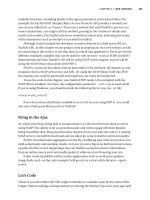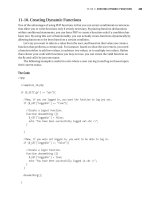Object-Oriented Programming with PHP 5 phần 8 pptx
Bạn đang xem bản rút gọn của tài liệu. Xem và tải ngay bản đầy đủ của tài liệu tại đây (366.07 KB, 26 trang )
Database in an OOP Way
[ 170 ]
Ability to create compressed connections
Ability to connect over SSL
Support for Prepared Statements
Support for Stored Procedure (SP)
Support for better replication and transaction
We will look into some of these features in the following examples. But of course we
are not going for anything introductory to MySQL, because that is out of scope for
this book. We will just show you how to use OO interface using MySQLi and how to
use some of these advanced features.
Connecting to MySQL in an OO Way
Remember those old days when you had to use procedural function call to
connect to MySQL, even from your objects. Those days are over. Now you can take
advantage of complete OO interface of MySQLi to talk to MySQL (well, there are a
few procedural methods, but overall it's completely OO). Take a look at the
following example:
<?
$mysqli = new mysqli("localhost", "user", "password", "dbname");
if (mysqli_connect_errno()) {
echo("Failed to connect, the error message is : ".
mysqli_connect_error());
exit();
}
?>
If the connection fails, you may get an error message like this:
Failed to connect, the error message is : Access denied for user
'my_user'@'localhost' (using password: �ES)
Selecting Data in an OO Way
Let's see how to select data from a table in an OO way using MySQLi API.
<?php
$mysqli = new mysqli("localhost", "un" "pwd", "db");
if (mysqli_connect_errno()) {
echo("Failed to connect, the error message is : ".
mysqli_connect_error());
exit();
•
•
•
•
•
Chapter 7
[ 171 ]
}
/* close connection */
$result = $mysqli ->query("select * from users");mysqli ->query("select * from users"); ->query("select * from users");
while ($data = $result->fetch_object())
{
echo $data->name." : '".$data->pass."' \n";
}
?>
The output is as following:
robin : 'no password'
tipu : 'bolajabena'
Please note that it is not good practice to store users' passwords in
plain text in your database without encrypting them in some way. The
best way is to store just the hash of their passwords using some hash
routines like md5()
Updating Data in an OO Way
There is no special deal with it. You can update your data as you previously did
with MySQL extension. But for the sake of OO style, we are showing an example of
how you can do that with mysqli_query() function as shown in the above example.
Instantiate an instance of MySQLi object and then run the query.
Prepared Statements
Here we are in a really interesting section which has been introduced for the rst
time in PHP OO using MySQLi extension. The prepared statements are introduced
in MySQL 5.0 versions (dynamic SQL) for better security and exibility. It has a great
performance boost over the regular one.
So what is actually a prepared statement? A prepared statement is nothing but
a regular query that is pre-compiled by the MySQL sever that could be invoked
later. Prepared statements reduce the chances of SQL injection and offers greater
performance over the general non-prepared queries, as it need not perform different
compilation steps at the run time.(It is already compiled, remember?)
The following are advantages of using prepared statements:
Better Performance
Prevention of SQL injection
Saving memory while handling blobs
•
•
•
Database in an OOP Way
[ 172 ]
But there are drawbacks too!
There is no performance boost if you use prepared statements for a
single call.
There is no query cache for using prepared statements.
Chance of memory leak if statements are not closed explicitly.
Not all statements can be used as a prepared statement.
Prepared statements can accept parameters at run time in the same order you
specify them whilst preparing the query. In this section we will learn about creating
prepared statements, passing values to them, and fetching results.
Basic Prepared Statements
Let's prepare a statement using PHP's native MySQLi extension. In the following
example we will make a prepared statement, execute it, and fetch the result from it:
<?
$mysqli = new mysqli("localhost", "un" "pwd", "db");
if (mysqli_connect_errno()) {
echo("Failed to connect, the error message is : ".
mysqli_connect_error());
exit();
}
$stmt = $mysqli ->prepare("select name, pass from users
order by name");
$stmt->execute();
//$name=null;
$stmt->bind_result($name, $pass);
while ($stmt->fetch())
{
echo $name."<br/>";
}
?>
So what did we actually do in the above example?
1. We prepared the statement using the following code:
$stmt = $mysqli->prepare("select name, pass from users order
by name");
•
•
•
•
Chapter 7
[ 173 ]
2. Then we executed it:
$stmt->execute();
3. Then we bound two variables with it, as there are two variables in our query:
$stmt->bind_result($name, $pass);
4. Finally we fetched the result using:
$stmt->fetch()
Whenever we called fetch(), the bound variables are populated with values. So we
can now use them.
Prepared Statements with Variables
The advantage of prepared statements is that you can use variables with queries.
First you can prepare the query by placing a ? sign at the appropriate place, and then
you can pass the value after preparing it. Let's have a look at the following example:
<?
$mysqli = new mysqli("localhost", "un" "pwd", "db");
if (mysqli_connect_errno()) {
echo("Failed to connect, the error message is : ".
mysqli_connect_error());
exit();
}
$stmt = $mysqli->prepare("select name, pass from users
where name=?");
$stmt->bind_param("s",$name); //binding name as string
$name = "tipu";
$stmt->execute();
$name=null;
$stmt->bind_result($name, $pass);
while ($r = $stmt->fetch())
{
echo $pass."<br/>";
}
?>
Here we prepare the query "select name, pass from users where name=?"
where the name is denitely a string type value. As we bind parameters in the
previous example for the result using bind_results(), here we have to bind
parameters using bind_params() function. Besides that, we need to supply the data
type of the parameters bound.
Database in an OOP Way
[ 174 ]
MySQL prepared statements support four types of parameters:
i, means the corresponding variable has type integer
d, means the corresponding variable has type double
s, means the corresponding variable has type string
b, means the corresponding variable is a blob and will be sent in packets
As our parameter is a string, we used the following line to bind the parameter:
$stmt->bind_param("s",$name);
After binding the variable, now we set the value to $name and call the execute()
function. After that we fetch the values as before After that we fetch the values as before.
Using BLOB with Prepared Statements
Prepared statements support handling BLOB or Binary Large Objects efciently. If
you manage BLOB with prepared statements, it will save you from greater memory
consumption by sending the data as packets. Let's see how we can store BLOB (in
this case, an image le).
Prepared statements support sending data in chunks using the send_long_data()
function. In the following example we will store the image using this function,
though you can send them as usual, unless your data exceeds the limit dened by
the max_allowed_packet MySQL conguration variable.MySQL conguration variable.
<?
$mysqli = new mysqli("localhost", "un" "pwd", "db");
if (mysqli_connect_errno()) {
echo("Failed to connect, the error message is : ".
mysqli_connect_error());
exit();
}
$stmt = $mysqli->prepare("insert into images value(NULL,?)");
$stmt->bind_param("b",$image);
$image = file_get_contents("signature.jpg");//fetching content of
//a file
$stmt->send_long_data(0,$image);
$stmt->execute();
?>
•
•
•
•
Chapter 7
[ 175 ]
Our table schema is as shown below:
CREATE TABLE 'images' (
'id' int(11) NOT NULL auto_increment,
'image' mediumblob,
PRIMAR� KE� ('id')
) ENGINE=MyISAM;
We choose medium BLOB as our data type because blob can store only 65KB of data,
where as medium BLOB can store more than 16MB, and long blob can store more
than 4GB data in it.
Now we will restore this BLOB data using the image again in prepared statement:
<?
$mysqli = new mysqli("localhost", "username", "password", "test");
if (mysqli_connect_errno()) {
echo("Failed to connect, the error message is : ".
mysqli_connect_error());
exit();
}
$stmt = $mysqli->prepare("select image from images where id=?");
$stmt->bind_param("i",$id);
$id = $_GET['id'];
$stmt->execute();
$image=NULL;
$stmt->bind_result($image);
$stmt->fetch();
header("Content-type: image/jpeg");
echo $image;
?>
Executing Stored Procedure with MySQLi and
PHP
Stored procedure is another new addition to MySQL 5 which reduces the need for
client-side queries to a great extent. Using MySQLi extension, you can execute stored
procedures in MySQL. We are not going to discuss stored procedures as that is out
of scope for this book. There are several articles available in the Internet that will
help you in writing stored procedures in MySQL. You can read this awesome one
for getting a basic idea about advanced MySQL features: />tech-resources/articles/mysql-storedprocedures.pdf
Database in an OOP Way
[ 176 ]
Let's create a small stored procedure and run it using PHP. This stored procedure
can take an input and insert that record in a table:
DELIMITER $$;
DROP PROCEDURE IF EXISTS 'test'.'sp_create_user'$$
CREATE PROCEDURE 'sp_create_user'(IN uname VARCHAR(50))
BEGIN
INSERT INTO users(id,name) VALUES (null, uname);
END$$
DELIMITER ;$$
If you run this stored procedure in your database (using MySQL query builder or
anything) the sp_create_user procedure will be created.
You can manually execute any stored, procedure from MySQL client
using "Execute" command. For example to execute the above stored
procedure you have to use call sp_create_user('username').
Now we will run this stored procedure using PHP code. Let's see.
<?
$mysqli = new mysqli("localhost", "username", "password", "test");
if (mysqli_connect_errno()) {
echo("Failed to connect, the error message is : ".
mysqli_connect_error());
exit();
}
$mysqli->query("call sp_create_user('hasin')");
?>
That's it!
PDO
Another new extension added in PHP 5.1 for managing databases is PDO (although
PDO was available with PHP 5.0 as a PECL Extension). This comes with a set of
drivers for working with different database engines. PDO stands for PHP Data
Objects. It is developed to provide a lightweight interface for different database
engines. And one of the very good features of PDO is that it works like a Data Access
Layer so that you can use the same function names for all database engines.
Chapter 7
[ 177 ]
You can connect to different databases using DSN (Data Source Name) strings. In the
following example we will connect to a MySQL databases and retrieve some data.
<?php
$dsn = 'mysql:dbname=test;host=localhost;';
$user = 'user';
$password = 'password';
try {
$pdo = new PDO($dsn, $user, $password);
}
catch (PDOException $e)
{
echo 'Connection failed: ' . $e->getMessage();
}
$result = $pdo->query("select * from users");
foreach ($result as $row)
echo $row['name'];
?>
That's fairly hassle free, right? It just connects to MySQL server with the DSN
(here it connects to test database) and then executes the query. And Finally we
display the result.
So what would this be like if we connected to a SQLite database?
<?php
$dsn = 'sqlite:abcd.db';
try
{
$pdo = new PDO($dsn);
$pdo->exec("CREATE TABLE users (id int, name VARCHAR)");
$pdo->exec("DELETE FROM users");
$pdo->exec("INSERT INTO users (name) VALUES('afif')");
$pdo->exec("INSERT INTO users (name) VALUES('tipu')");
$pdo->exec("INSERT INTO users (name) VALUES('robin')");
}
catch (PDOException $e) {
echo 'Connection failed: ' . $e->getMessage();
}
$result = $pdo->query("select * from users");
foreach ($result as $row)
echo $row['name'];
?>
See there is no change in the code except the DSN.
Database in an OOP Way
[ 178 ]
You can also create a SQLite database in memory and perform the operation there.
Let's see the following code:
<?php
$dsn = 'sqlite::memory:';
try {
$pdo = new PDO($dsn);
$pdo->exec("CREATE TABLE users (id int, name VARCHAR)");
$pdo->exec("DELETE FROM users");
$pdo->exec("INSERT INTO users (name) VALUES('afif')");
$pdo->exec("INSERT INTO users (name) VALUES('tipu')");
$pdo->exec("INSERT INTO users (name) VALUES('robin')");
}
catch (PDOException $e)
{
echo 'Connection failed: ' . $e->getMessage();
}
$result = $pdo->query("select * from users");
foreach ($result as $row)
echo $row['name'];
?>
We just changed the DSN here.
DSN Settings for Different Databases Engines
Let us take a look at the DSN settings for different database engines to connect
with PDO. Supported database drivers are as shown below:
PDO_DBLIB for FreeTDS/Microsoft SQL Server/Sybase
PDO_FIREBIRD for Firebird/Interbase 6
PDO_INFORMIX for IBM Informix Dynamic Server
PDO_MYSQL for MySQL 3.x/4.x/5.x
PDO_OCI for Oracle Call Interface
PDO_ODBC for ODBC v3 (IBM DB2, unixODBC and win32 ODBC)
PDO_PGSQL for PostgreSQL
PDO_SQLITE for SQLite 3 and SQLite 2
•
•
•
•
•
•
•
•
Chapter 7
[ 179 ]
Let's have a look at these sample driver-specic DSN settings:
mssql:host=localhost;dbname=testdb
sybase:host=localhost;dbname=testdb
dblib:host=localhost;dbname=testdb
firebird:User=john;Password=mypass;Database=DATABASE.GDE;
DataSource=localhost;Port=3050
informix:host=host.domain.com; service=9800;database=common_db;
server=ids_server; protocol=onsoctcp;EnableScrollableCursors=1
mysql:host=localhost;port=3307;dbname=testdb
mysql:unix_socket=/tmp/mysql.sock;dbname=testdb
oci:mydb
oci:dbname=//localhost:1521/mydb
odbc:testdb
odbc:DRIVER={IBM DB2 ODBC
DRIVER};HOSTNAME=localhost;PORT=50000;DATABASE=SAMPLE;PROTOCOL=TCPIP;
UID=db2inst1;PWD=ibmdb2;
odbc:Driver={Microsoft Access Driver
(*.mdb)};Dbq=C:\\db.mdb;Uid=Admin
pgsql:dbname=example;user=nobody;password=change_me;host=localhost;
port=5432
sqlite:/opt/databases/mydb.sq3
sqlite::memory:
sqlite2:/opt/databases/mydb.sq2
sqlite2::memory:
Using Prepared Statements with PDO
Using PDO you can run prepared statements against your database. The benets are
the same as before. It increases the performance for multiple calls by parsing and
caching the server-side query and it also eliminates the chance of SQL injection.
PDO prepared statements can take named variables, unlike what we've seen in the
examples of MySQLi.
Let's take a look at the following example to understand this:
<?php
$dsn = 'mysql:dbname=test;host=localhost;';
$user = 'username';
$password = 'password';
try {
$pdo = new PDO($dsn, $user, $password);
Database in an OOP Way
[ 180 ]
} catch (PDOException $e)
{
echo 'Connection failed: ' . $e->getMessage();
}
$stmt = $pdo->prepare("select id from users where name=:name");
$name = "tipu";
$stmt->bindParam(":name",$name, PDO::PARAM_STR);
$stmt->execute();
$stmt->bindColumn("id",$id);
$stmt->fetch();
echo $id;
?>
But you can also run the example like this:
<?php
$dsn = 'mysql:dbname=test;host=localhost;';
$user = 'username';
$password = 'password';
try {
$pdo = new PDO($dsn, $user, $password);
}
catch (PDOException $e)
{
echo 'Connection failed: ' . $e->getMessage();
}
$stmt = $pdo->prepare("select id from users where name=?");
$name = "tipu";
$stmt->bindParam(1,$name, PDO::PARAM_STR);
$stmt->execute();
$stmt->bindColumn("id",$id);
$stmt->fetch();
echo $id;
?>
Instead of calling bindParam(), you can use bindValues() like the following one:
$stmt->bindValue(1,"tipu", PDO::PARAM_STR);
Calling Stored Procedures
PDO provides an easy way to call stored procedures. All you have to do is run
"CALL SPNAME(PARAMS)" via exec() method:
$pdo->exec("CALL sp_create_user('david')");
Chapter 7
[ 181 ]
Other Interesting Functions
There are several other interesting functions available in PDO. For example, take a
look at the list below:
fetchAll()
fetchColumn()
rowCount()
setFetchMode()
The fetchAll() function can fetch all records from a result set. Let's have a look at
the following example:
$stmt = $pdo->prepare("select * from users");
$stmt->execute();
echo "<pre>";
print_r($stmt->fetchAll());
echo "</pre>";
The fetchColumn() function helps to select data from any specic column after
executing the statement. Let's take a look:
$stmt = $pdo->prepare("select * from users");
$stmt->execute();
while ($name = $stmt->fetchColumn(1))
{
echo $name."<br/>";
}
rowCount() returns the number of affected rows after performing any UPDATE or
DELETE query. But you must remember that it returns the number of affected rows
by the latest executed query.
$stmt = $pdo->prepare("DELETE from users WHERE name='Anonymous'");
$stmt->execute();
echo $stmt->rowCount();
setFetchMode() helps you to set the fetch mode of PDO prepared statements. The
available values are:
PDO::FETCH_NUM: Fetch results as a numerically indexed array
PDO::FETCH_ASSOC: Fetch rows as index by column names as keys
PDO::FETCH_BOTH: Fetch as both of the above
PDO::FETCH_OBJ: Fetch the rows as objects where column names are set
as properties.
•
•
•
•
•
•
•
•
Database in an OOP Way
[ 182 ]
Introduction to Data Abstraction Layers
Data Abstraction Layers (DALs) are developed to provide unied interfaces to work
with every database engine. It provides similar API to work with every database
engine independently. As the function names are similar for all platforms, they are
easier to work with, easier to remember, and of course make your code portable. To
make you understand the necessity of DAL, let me explain a common scenario.
Suppose Team Y gets a big project. Their client says that they will use MySQL. So
team Y develops the application and when the time comes to deliver, the client
requests the team to give support for PostgreSQL. They will pay for this change but
they require the change early.
Team Y had designed the application using all native MySQL functions. So what will
Team Y do? Will they rewrite everything to give support for PostgreSQL? Well, that
is the only way they have to. But what will happen if they need to give support for
MSSQL in the near future? Another rewrite? Can you imagine the cost of refactoring
each and every time?
To save from these disasters, here comes the need for DAL where the code will
remain the same and it could be changed to support any DB at any time without any
major change.
There are many popular libraries to implement DAL for PHP. To name some of
those, ADOdb and PEAR::MDB2 are very popular. PEAR::DB was very popular
but its development has been discontinued ( />index.php?/archives/42-PEARDB-is-DEPRECATED,-GOT-IT.html#extended).
In this section we will discuss PEAR::MDB2 and ADOdb. We will see the
basic database operations using it and learn how to install these libraries for
working around.
ADOdb
ADOdb is a nice and popular data abstraction layer developed by John Lim and
released under LGPL. This is one of the very best data abstraction layers for PHP.
You can get the latest version of ADOdb from .
Installing ADOdb
There is no install of ADodb as such. It is a set of classes and regular scripts. So all
you have to do is just extract the archive in a location from where you can include
the script. Let's take a look at the following image to understand the directory
structure after extracting:
Chapter 7
[ 183 ]
Connecting to Different Databases
Like PDO, you can connect to different database drivers using ADOdb. DSN is
different from PDO. Let's take a look at the supported database list and their DSN
strings.
ADOdb supports a common DSN format, like this:
$driver://$username:$password@hostname/$database?options[=value]
So what are the available drivers supported by ADOdb? Let's take a look below. This
is a list taken from the ADOdb manual for your understanding:
Name Tested Database Prerequisites Operating
Systems
access B Microsoft Access/Jet. You need to create
an ODBC DSN.
ODBC Windows
only
ado B Generic ADO, not tuned for specic
databases. Allows DSN-less connections.
For best performance, use an OLEDB
provider. This is the base class for all
ado drivers.
You can set $db->codePage before
connecting.
ADO or
OLEDB
provider
Windows
only
ado_access B Microsoft Access/Jet using ADO.
Allows DSN-less connections. For best
performance, use an OLEDB provider.
ADO or
OLEDB
provider
Windows
only
Database in an OOP Way
[ 184 ]
Name Tested Database Prerequisites Operating
Systems
ado_mssql B Microsoft SQL Server using ADO.
Allows DSN-less connections. For best
performance, use an OLEDB provider.
ADO or
OLEDB
provider
Windows
only
db2 C Uses PHP's db2-specic extension for
better performance.
DB2 CLI/
ODBC interface
Unix and
Windows.
Requires
IBM DB2
Universal
Database
client
odbc_db2 C Connects to DB2 using generic ODBC
extension.
DB2 CLI/
ODBC interface
Unix and
Windows.
Unix install
hints. I have
had reports
that the
$host and
$database
params
have to be
reversed in
Connect()
when using
the CLI
interface
vfp A Microsoft Visual FoxPro. You need to
create an ODBC DSN.
ODBC Windows
only
fbsql C FrontBase. ? Unix and
Windows
ibase B Interbase 6 or earlier. Some users report
you might need to use this
$db->PConnect('localhost:c:/
ibase/employee.gdb', "sysdba",
"masterkey") to connect. Lacks
Affected_Rows currently.
You can set $db->role, $db->dialect,
$db->buffers and $db->charSet
before connecting.
Interbase client Unix and
Windows
rebird B Firebird version of interbase. Interbase client Unix and
Windows
borland_
ibase
C Borland version of Interbase 6.5 or later.
Very sad that the forks differ.
Interbase client Unix and
Windows
Chapter 7
[ 185 ]
Name Tested Database Prerequisites Operating
Systems
informix C Generic informix driver. Use this if you are
using Informix 7.3 or later.
Informix client Unix and
Windows
informix72 C Informix databases before Informix 7.3
that do no support SELECT FIRST.
Informix client Unix and
Windows
ldap C LDAP driver. See this example for usage
information.
LDAP
extension
?
mssql A Microsoft SQL Server 7 and later. Works
with Microsoft SQL Server 2000 also. Note
that date formating is problematic with
this driver. For example, the PHP MSSQL
extension does not return the seconds for
datetime!
Mssql client Unix and
Windows.
Unix install
howto and
another one.
mssqlpo A Portable mssql driver. Identical to
above mssql driver, except that '||', the
concatenation operator, is converted to '+'.
Useful for porting scripts from most other
sql variants that use ||.
Mssql client Unix and
Windows.
Unix install
howto.
mysql A MySQL without transaction support. You
can also set $db->clientFlags before
connecting.
MySQL client Unix and
Windows
mysqli B Supports the newer PHP5 MySQL API. MySQL 4.1+
client
Unix and
Windows
mysqlt or
maxsql
A MySQL with transaction support. We
recommend using || as the concat
operator for best portability. This can be
done by running MySQL using:
mysqld ansi or mysqld sql-
mode=PIPES_AS_CONCAT
MySQL client Unix and
Windows
oci8 A Oracle 8/9. Has more functionality than
oracle driver (eg. Affected_Rows).
You might have to putenv('ORACLE_
HOME= ') before Connect/PConnect.
There are 2 ways of connecting: with
server IP and service name:
PConnect('serverip:1521','scott
','tiger','service')
or using an entry in TNSNAMES.ORA or
ONAMES or HOSTNAMES:
PConnect(false, 'scott',
'tiger', $oraname).
Since 2.31, we support Oracle REF cursor
variables directly (see ExecuteCursor).
Oracle client Unix and
Windows
Database in an OOP Way
[ 186 ]
Name Tested Database Prerequisites Operating
Systems
oci805 C Supports reduced Oracle functionality
for Oracle 8.0.5. SelectLimit is not as
efcient as in the oci8 or oci8po drivers.
Oracle client Unix and
Windows
oci8po A Oracle 8/9 portable driver. This is nearly
identical with the oci8 driver except (a)
bind variables in Prepare() use the ?
convention, instead of :bindvar, (b)
eld names use the more common PHP
convention of lowercase names.
Use this driver if porting from other
databases is important. Otherwise the oci8
driver offers better performance.
Oracle client Unix and
Windows
odbc A Generic ODBC, not tuned for specic
databases. To connect, use
PConnect('DSN','user','pwd').
This is the base class for all ODBC derived
drivers.
ODBC Unix and
Windows.
Unix hints
odbc_mssql A Uses ODBC to connect to MSSQL ODBC Unix and
Windows
odbc_oracle C Uses ODBC to connect to Oracle ODBC Unix and
Windows
odbtp B Generic odbtp driver. Odbtp is a software
for accessing Windows ODBC data sources
from other operating systems.
odbtp Unix and
Windows
odbtp_
unicode
C Odtbp with unicode support odbtp Unix and
Windows
oracle C Implements old Oracle 7 client API.
Use oci8 driver if possible for better
performance.
Oracle client Unix and
Windows
netezza C Netezza driver. Netezza is based on
PostGREs code-base.
? ?
pdo C Generic PDO driver for PHP5. PDO extension
and database
specic drivers
Unix and
Windows
postgres A Generic PostgreSQL driver. Currently
identical to postgres7 driver.
PostgreSQL
client
Unix and
Windows
postgres64 A For PostgreSQL 6.4 and earlier which does
not support LIMIT internally.
PostgreSQL
client
Unix and
Windows
postgres7 A PostgreSQL which supports LIMIT and
other version 7 functionality.
PostgreSQL
client
Unix and
Windows
Chapter 7
[ 187 ]
Name Tested Database Prerequisites Operating
Systems
postgres8 A Currently identical to postgres7. PostgreSQL
client
Unix and
Windows
sapdb C SAP DB. Should work reliably as based on
ODBC driver.
SAP ODBC
client
?
sqlanywhere C Sybase SQL Anywhere. Should work
reliably as based on ODBC driver.
SQL
Anywhere
ODBC client
?
sqlite B SQLite. - Unix and
Windows
sqlitepo B Portable SQLite driver. This is because
assoc mode does not work like other
drivers in SQLite. Namely, when selecting
(joining) multiple tables, the table names
are included in the assoc keys in the
"sqlite" driver.
In "sqlitepo" driver, the table names are
stripped from the returned column names.
When this results in a conict, the rst
eld get preference.
- Unix and
Windows
sybase C Sybase. Sybase client Unix and
Windows
Basic Database Operations using ADOdb
Remember the directory structure that saw minutes ago? Now we are going to make
use of those scripts. In this section we will learn basic database operation using
ADOdb. Let's connect to MySQL and perform a basic operation:
<?
include("adodb/adodb.inc.php");
$dsn = 'mysql://username:password@localhost/test?persist';
$conn = ADONewConnection($dsn);
$conn->setFetchMode(ADODB_FETCH_ASSOC);
$recordSet = $conn->Execute('select * from users');
if (!$recordSet)
print $conn->ErrorMsg(); //if any error is there
else
while (!$recordSet->EOF) {
echo $recordSet->fields['name'].'<BR>';
$recordSet->MoveNext();
}
?>
Database in an OOP Way
[ 188 ]
Let's see an alternate connection example:
<?
include("adodb/adodb.inc.php");
$conn =ADONewConnection('mysql');//just the RDBMS type
$conn->connect("localhost","username","password","test");
//here comes the credentials
?>
Inserting, Deleting, and Updating Records
You can execute any SQL statement using execute() method of ADONewConnection
or ADOConnection object. So nothing is new here. But let's see how can we insert/
delete/update some records and track the success or failure.
<?
include("adodb/adodb.inc.php");
$conn =ADONewConnection('mysql');
$conn->connect("localhost","user","password","test");
$conn->setFetchMode(ADODB_FETCH_ASSOC);
$res = $conn->execute("insert into users(name) values('test')");
echo $conn->Affected_Rows();
?>
So, Affected_Rows gives you the result for these scenarios.
Insert Id
If you are looking to nd the latest inserted ID, you can use the
Insert_Id() function.
Executing Prepared Statements
ADOdb provides easy API to create and execute prepared statements. Let's take a
look at the following example to understand how that works:
<?
include("adodb/adodb.inc.php");
$conn =ADONewConnection('mysql');
$conn->connect("localhost","user","password","test") ;
$conn->setFetchMode(ADODB_FETCH_ASSOC);
$stmt = $conn->Prepare('insert into users(name) values (?)');
$conn->Execute($stmt,array((string) "afif"));
echo $conn->Affected_Rows();
?>
Chapter 7
[ 189 ]
You can retrieve records in the same way.
MDB2
MDB2 is another popular data abstraction library developed under PEAR by
combining the best features of PEAR::DB and Metabase. It provides very consistent
API, improved performance, and solid development platform over DB and MDB.
MDB2 comes with an excellent set of documentation. In this chapter we surely
cannot cover all the features supported by MDB2 but we will go through the basic
features to make you understand how it works.
Installing MDB2
Installing MDB2 requires a working version of PEAR. So to work with MDB2 you
must have PEAR installed and functioning in your machine. If you don't have PEAR
installed, the following tip will be helpful for you.
Installing PEAR
Go to and save the page asand save the page as go-
pear.php in your hard drive. Now apply the command php /path/
to/go-pear.php in your shell or command prompt and follow the
instructions there. If it asks whether you want to install MDB2, say 'Yes'.
Also say Yes, if it wants to modify your php.ini le. Don't worry, it will
just add entries to make PEAR available in your current include path, and
all other settings will remain the same as before. So you are done.
If you have PEAR I installed but not MDB2, then you can install it in a second. Open
your shell or command prompt and apply the following commands:
pear install MDB2
pear install MDB2_Driver_$driver
Where $driver could be anything like SQLite, PgSQL, MySQL, MYSQLi, oci8,
MSSQL, and ibase. So for example, to install MySQL driver you have to apply
the command:
pear install MDB2_Driver_mysqlmysql
That's it. You are done.
Database in an OOP Way
[ 190 ]
Connecting to Database
Using MDB2 you can connect to different database engines. MDB2 also has a
formatted DSN string to connect. The format of that DSN is as shown:
phptype(dbsyntax)://username:password@protocol+hostspec/database?
option=value
But there are some variations in this DSN. These are listed here:
phptype://username:password@protocol+hostspec:110//usr/db_file.db
phptype://username:password@hostspec/database
phptype://username:password@hostspec
phptype://username@hostspec
phptype://hostspec/database
phptype://hostspec
phptype:///database
phptype:///database?option=value&anotheroption=anothervalue
The supported drivers (PHPtype) are shown here:
fbsql -> FrontBase
ibase -> InterBase / Firebird (requires PHP 5)
mssql -> Microsoft SQL Server (NOT for Sybase. Compile PHP with-
mssql)
mysql -> MySQL
mysqli -> MySQL (supports new authentication protocol) (requires
PHP 5)
oci8 -> Oracle 7/8/9/10
pgsql -> PostgreSQL
querysim -> QuerySim
sqlite -> SQLite 2
Now let's connect to MySQL:
<?php
set_include_path(get_include_path().";".
"C:/Program Files/PHP/pear;");
require_once 'MDB2.php';
$dsn = 'mysql://user:password@localhost/test';
$options = array('persistent' => true
);
$mdb2 = MDB2::factory($dsn, $options);
if (PEAR::isError($mdb2)) {
die($mdb2->getMessage());
Chapter 7
[ 191 ]
}
//
$result = $mdb2->query("select * from users");
while ($row = $result->fetchRow(MDB2_FETCHMODE_ASSOC))
{
echo $row['name']."\n";
}
$mdb2->disconnect();
?>
Executing Prepared Statements
You can execute prepared statements using MDB2 easily. MDB2 provides exible
API for creating and executing prepared statements. In the following example we
will execute two types of prepared statements. One which will just execute some
insert/update/delete queries, and another which will return some data as output.
<?php
set_include_path(get_include_path().";".
"C:/Program Files/PHP/pear;");
require_once 'MDB2.php';
$dsn = 'mysql://user:password@localhost/test';
$options = array('persistent' => true
);
$mdb2 = MDB2::factory($dsn, $options);
if (PEAR::isError($mdb2)) {
die($mdb2->getMessage());
}
$stmt = $mdb2->Prepare("insert into users(name)
values(?)",array("text"),MDB2_PREPARE_MANIP);
//for DML statements, we should use MDB2_PREPARE_MANIP and For
//Reading we should use MDB2_PREPARE_RESULT
echo $stmt->execute("Mohiuddin");
$stmt = $mdb2->Prepare("select name from users where
id=?",array("integer"),array("text"));
$result = $stmt->execute(11);
if (PEAR::isError($result))
echo $result->getMessage();
while ($row = $result->fetchRow())
{
echo $row[0];
}
?>
Database in an OOP Way
[ 192 ]
Now what if we want to insert in multiple elds? Well for example, if we have
another eld like "age" in our table, we need to pass data like this:
$stmt = $mdb2->Prepare("insert into users(name,age)
values(?)",array("text","integer"),MDB2_PREPARE_MANIP);
echo $stmt->execute("Mohiuddin",2);
Or:
$stmt = $mdb2->Prepare("insert into users(name,age)
values(?)",array("text","integer"),MDB2_PREPARE_MANIP);
echo $stmt->execute(array("Mohiuddin",2));
So we can also insert multiple rows at once using executeMultiple() method:
$stmt = $mdb2->Prepare("insert into users(name,age) values(?)",
array("text","integer"),MDB2_PREPARE_MANIP);
echo $stmt->executeMultiple(array(array("Mohiuddin",2),
array("another",3));
That's it.
Introduction to ActiveRecord
ActiveRecord is a design pattern created to solve the data accessing problem in a
fairly readable manner. Using ActiveRecord design pattern you can manipulate data
like a charm. In this section we will go through the basic features of an ActiveRecord
implementation in PHP.
Let's see how ActiveRecord actually works. For this, we will use ADOdb's active
record implementation. Adodb provides a class named Adodb_Active_Record
devoted to it.
Let's create a table in our database with the following structure:
CREATE TABLE 'users' (
'id' int(11) NOT NULL auto_increment,
'name' varchar(250),
'pass' varchar(32),
PRIMAR� KE� ('id')
) ENGINE=MyISAM;
Chapter 7
[ 193 ]
Creating a New Record via ActiveRecord
Now we will create a new user in this table. Have a look at the following code:
<?
include("adodb/adodb.inc.php");
include('adodb/adodb-active-record.inc.php');
$conn =ADONewConnection('mysql');
$conn->connect("localhost","user","password","test") ;
ADODB_Active_Record::setDatabaseAdapter($conn);
class User extends ADODB_Active_Record {}
$user = new User();//a dynamic model to access the user table
$user->name = "Packt";
$user->pass = "Hello";
$user->save();//calling save() will internally save this
//record in table
?>
ActiveRecord exposes a separate object for every table in your database by which you
can perform different operations. Let's take a look at how we can select some data.
Selecting and Updating Data
We can load and change any record using ActiveRecord easily. Let's have a look at
the following example:
<?
include("adodb/adodb.inc.php");
include('adodb/adodb-active-record.inc.php');
$conn =ADONewConnection('mysql');
$conn->connect("localhost","user","password","test") ;
ADODB_Active_Record::setDatabaseAdapter($conn);
class User extends ADODB_Active_Record {}
$user = new User();
$user->load("id=10");//load the record where the id is 10
echo $user->name;
$user->name= "Afif Mohiuddin";//now update
$user->save();//and save the previously loaded record
?>
So that's fairly easy. When you call the load() method with any expression, the
record will be loaded into the object itself. Then you can make any change and nally
save it. ActiveRecord is extremely charming to work with.
Database in an OOP Way
[ 194 ]
Summary
You nished reading a chapter devoted for total DB access using the OOP way.
There are lot other interesting projects like Propel ( />trac/) as Object Relational Mapping library for PHP developers, Creole
( as a DAL, ActiveRecord library from
CodeIgniter framework (), and many more. You
have got a large number of resources available to manipulate database using PHP5
and OO style.
In the next chapter we will learn about using XML in PHP. You will be surprised
to nd that you can use plain XML les as a lightweight alternative of regular
heavyweight database engines. Until then, happy coding.









